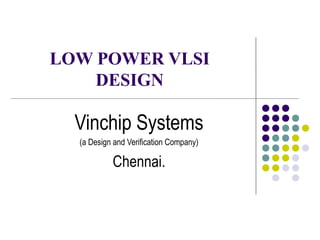Low power vlsi design
•Descargar como PPT, PDF•
27 recomendaciones•24,824 vistas
Denunciar
Compartir
Denunciar
Compartir

Recomendados
Recomendados
Más contenido relacionado
La actualidad más candente
La actualidad más candente (20)
POWER CONSUMPTION AT CIRCUIT OR LOGIC LEVEL IN CIRCUIT

POWER CONSUMPTION AT CIRCUIT OR LOGIC LEVEL IN CIRCUIT
Analysis of Power Dissipation & Low Power VLSI Chip Design

Analysis of Power Dissipation & Low Power VLSI Chip Design
low pw and leakage current techniques for cmos circuits

low pw and leakage current techniques for cmos circuits
Similar a Low power vlsi design
Similar a Low power vlsi design (20)
Optimized Design of an Alu Block Using Power Gating Technique

Optimized Design of an Alu Block Using Power Gating Technique
A verilog based simulation methodology for estimating statistical test for th...

A verilog based simulation methodology for estimating statistical test for th...
Analysis Of Optimization Techniques For Low Power VLSI Design

Analysis Of Optimization Techniques For Low Power VLSI Design
SURVEY ON POWER OPTIMIZATION TECHNIQUES FOR LOW POWER VLSI CIRCUIT IN DEEP SU...

SURVEY ON POWER OPTIMIZATION TECHNIQUES FOR LOW POWER VLSI CIRCUIT IN DEEP SU...
SURVEY ON POWER OPTIMIZATION TECHNIQUES FOR LOW POWER VLSI CIRCUIT IN DEEP SU...

SURVEY ON POWER OPTIMIZATION TECHNIQUES FOR LOW POWER VLSI CIRCUIT IN DEEP SU...
SURVEY ON POWER OPTIMIZATION TECHNIQUES FOR LOW POWER VLSI CIRCUIT IN DEEP SU...

SURVEY ON POWER OPTIMIZATION TECHNIQUES FOR LOW POWER VLSI CIRCUIT IN DEEP SU...
Analysis Of Power Dissipation Amp Low Power VLSI Chip Design

Analysis Of Power Dissipation Amp Low Power VLSI Chip Design
Más de Vinchipsytm Vlsitraining
Más de Vinchipsytm Vlsitraining (12)
Low power vlsi design
- 1. LOW POWER VLSI DESIGN Vinchip Systems (a Design and Verification Company) Chennai.
- 2. Introduction Due to integration of components increased the power comes in lime light It is much important that handheld devices must possess low power devices For better performance For long run time (Battery time)
- 3. Definition Power Dissipation: The rate of energy which is taken from the source and converted into heat
- 4. Types of Power Dissipation Static power dissipation Due to leakage current Dynamic Power dissipation Due to switching activities of transistor
- 6. Low Power Design Space Three parts that we can perform low power techniques to reduce power dissipation Voltage Physical Capacitance Switching activity
- 7. Supply voltage reduction Voltage reduction offers an effective means of power reduction A factor of two reduction in supply voltage yields a factor of four decreases in power consumption But the performance is also getting reduced To avoid the above stated problem, Threshold voltage should be scaled down
- 8. Physical Capacitance Dynamic power consumption depends linearly on the physical capacitance being switched So minimizing capacitance offers another technique to for minimizing power consumption The capacitor can be kept as small by.. Minimum logic Smaller devices Fewer and shorter wires
- 9. Switching Activity There are two components to switching activity : which determines the average periodicity of data arrivals E (sw) which determines how many transitions each arrival will generate Switching activity is reduced by Selecting proper algorithms architecture optimization, Proper choice of logic topology Logic level optimization which results in less power
- 11. Low power Techniques Clock Gating To reducing dynamic power dissipation works by taking the enable conditions attached to registers, and uses them to gate the clocks Power Gating High Vt sleep transistors which cut off VDD from a circuit block when the block is not switching Also known as MTCMOS - Multi-Threshold CMOS
- 12. Calculation of Switching Activity Input Pattern Dependence Logic Function Logic Style Circuit Structure
- 13. Power Minimization Techniques Reducing chip and package capacitance Process development such as SOI with partially or fully depleted wells Advanced interconnect substrates such as Multi-Chip Modules (MCM). Scaling the supply voltage Very effective But often requires process technologies Employing better design techniques The investment to reduce power by design is relatively small Using power management strategies Various static and dynamic power management techniques
- 14. CAD Methodologies and Techniques Low power VLSI design can be achieved at various levels of the design process System Design inactive hardware modules may be automatically turned off to save power Behavioral Synthesis The behavioral synthesis process consists of three steps: Allocation Assignment and scheduling These steps determine how many instances of each resource are needed Logic Synthesis Physical Design
- 15. Conclusion Low power VLSI is needed Increasing of handheld devices Increasing of complex device structure Long battery life Long device life
